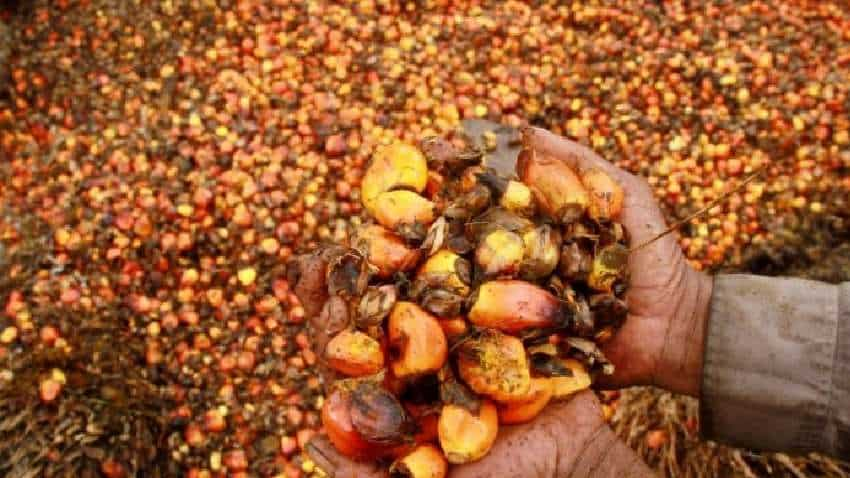Palm oil prices in focus – experts decode factors behind rise and demand outlook
Zee Business’ Mrityunjay Jha discusses the price and demand outlook in palm oil with Nirav Desai - Partner - GGN International, Amit Sajeja, VP of Research - Commodities & Currencies at Motilal Oswal, Jateen N Trivedi, VP of Research, LKP Securities Ltd; and Sandeep Bajoria, CEO, Sunvin Group.

Palm oil prices continue to remain bullish amid reports of lower production in Indonesia – the largest producer of palm oil in the world – and other variables such as higher demand, Islamic month fasting Ramadan, DMO (domestic market obligation) restrictions by the Indonesian government, and other geo-political issues, experts told Zee Business.
“Palm oil which used to be the cheapest among other oils is now more expensive than sunflower and soya oil. Over the last two weeks, palm oil prices have been increasing and the price is $15-$45 more than soya and sunflower oil,” Sandeep Bajoria, CEO, Sunvin Group told Zee Business.
On factors behind the rise in palm oil prices, Bajoria said, "It is a demand supply issue. Palm oil which is generally very cheaper and mostly remains $100-$150 less than other oils is the most expensive now. Even in September-October last year, it was $500 cheaper than sunflower and soya oil. The government had earlier raised duty on RBD (refined, bleached and deodorised oil) oil by $50 which is now increased to $151. Due to less supply, the April-May shipment of CPO (crude palm oil) has become expensive.”
“The new April-May shipment price of palm oil is $1040-$1050, the soya oil price is $1035-$1040 and sunflower oil is $1010,” Bajoria further added.
Meanwhile, the palm oil market is expected to generate an average CAGR of 4.48 per cent globally between 2023 and 2033. The market share is expected to rise to from the current US$ 70.95 billion to US$109.97 billion by 2033 , as per a recent analysis by Future Market Insights, Inc.
"The core demand of palm oil is 5 lakh tonne per month. When it was cheaper last year, we used to import 10-11 lakh tonne of palm oil every month. It will be the same for CPO. Other than that, we are importing 3.5 lakh tonne soya oil, 2-2.5 lakh tonne sunflower oil, and 6 lakh tonne soft oil," said Bajoria while adding that we have a good production of rice bran oil and mustard oil in India.
On the price difference of oils, GGN International’s Nirav Desai said, there is a very big trade deficit in Argentina. The government can’t make it free float due to economic issues but it is trying to control the deficit. Therefore, the pressure is on soya and sunflower oil. If we talk about palm oil, Indonesia's policy has become very protective, and due to Ramadan, they have increased PMO, domestic market obligation, and export tariffs. But we may see a relaxation in all these policies after May 15.
Can we expect a further price reduction in retail oil price in the future, Bajoriya said, "The ongoing retail oil price is the lowest. Even if the price drops, it will not be more than Rs 2 per kg.”
In response to concerns over the Black Sea grain corridor arrangement, Malaysian palm oil futures increased by more than 3 per cent on Tuesday morning at MYR 3,760 per tonne recovering from the three-week low of MYR 3,640 reached on April 17. A lower Malaysian ringgit also provided some assistance. While at the time of writing this article, palm oil futures was 2.10 per cent down at 4,014 MYR.
Meanwhile, India's palm oil imports jumped 28 per cent in March from an eight-month low in February as refiners reduced their purchases of soy oil and sun oil in response to discounts on the tropical oil. India, the largest importer of vegetable oils in the world, has increased its purchases of palm oil, which may help Malaysia reduce its stocks and maintain palm oil prices.
Get Latest Business News, Stock Market Updates and Videos; Check your tax outgo through Income Tax Calculator and save money through our Personal Finance coverage. Check Business Breaking News Live on Zee Business Twitter and Facebook. Subscribe on YouTube.
RECOMMENDED STORIES

Rs 3,500 Monthly SIP for 35 years vs Rs 35,000 Monthly SIP for 16 Years: Which can give you higher corpus in long term? See calculations

Small SIP, Big Impact: Rs 1,111 monthly SIP for 40 years, Rs 11,111 for 20 years or Rs 22,222 for 10 years, which do you think works best?
06:38 PM IST









 India's April palm oil imports jump 34% on lower global prices
India's April palm oil imports jump 34% on lower global prices Sunflower oil import touches record 4.45 lakh tonnes in March: SEA
Sunflower oil import touches record 4.45 lakh tonnes in March: SEA India's palm oil, sunoil imports rise to record highs; soyoil drops
India's palm oil, sunoil imports rise to record highs; soyoil drops India's palm oil imports fall 15% to 4.39 lakh tonne in May
India's palm oil imports fall 15% to 4.39 lakh tonne in May Godrej Agrovet, SBI partner to offer loans to oil palm farmers
Godrej Agrovet, SBI partner to offer loans to oil palm farmers